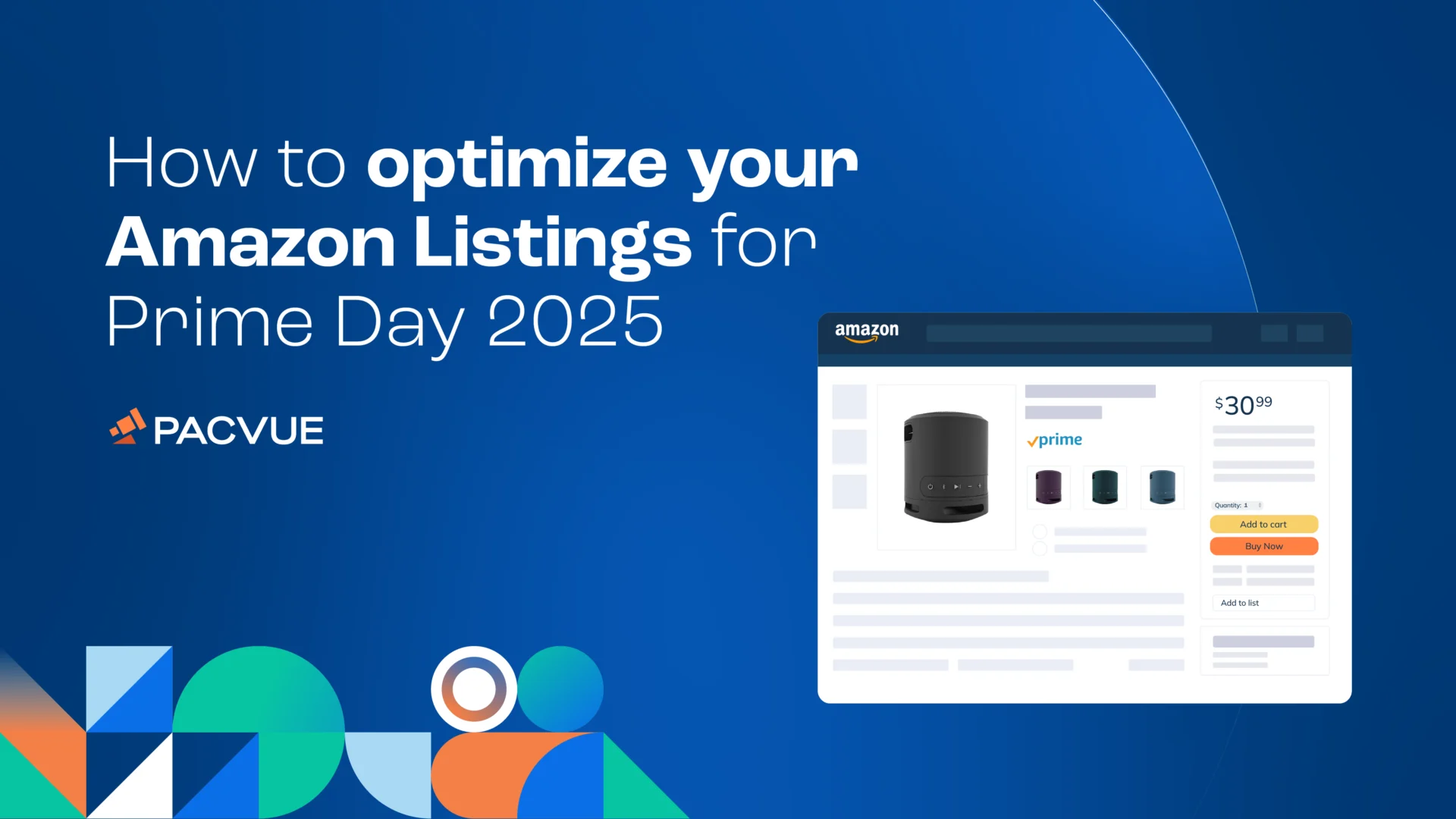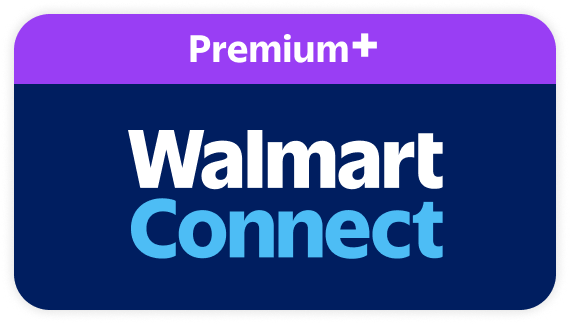With the longest-ever Prime Day fast approaching, preparation is everything. It’s a major opportunity for brands and agencies to boost visibility, attract new customers, and exceed sales goals.
One of the most important areas to focus on? Your Amazon Product Detail Pages (PDPs). Optimizing your listings ensures your products appear when and where shoppers are searching—improving discoverability and driving conversions.
To help you get ahead, we’ve outlined key strategies to sharpen your PDP performance and retail readiness. Here’s what you’ll take away:
- Optimize Amazon PDPs for visibility and conversion using keywords, visuals, and social proof
- Stay ahead of evolving search with Rufus AI and intent-based discovery
- Prepare your listings and operations for retail-readiness: pricing, inventory, and fulfillment
- Scale and automate campaigns with Pacvue’s cross-platform tools, including TikTok and AMC
Why optimizing your PDP matters for Prime Day
When high-intent shoppers land on your PDP, it’s your most critical moment, and your final opportunity to convert. A well-optimized PDP doesn’t just influence conversions; it also plays a key role in:
- Driving organic traffic by surfacing your product in relevant search results through strategic keyword placement
- Improving Buy Box eligibility, giving your brand a competitive edge
- Maximizing return on ad spend (ROAS)—because even the best ad campaigns won’t convert if they lead to underperforming product pages
How to Drive Traffic to Your Amazon Listing for Prime Day 2025
To maximize visibility during Prime Day, your Amazon listing needs more than just the right keywords. Yes, including top-performing terms in your title, bullets, and description is essential—but it’s only one part of the algorithmic equation.
Amazon ranks listings based on a combination of relevance and performance. The pages that rise to the top demonstrate strong engagement signals—sales velocity, conversion rates, and customer satisfaction metrics like reviews and return rates.
During Prime Day, Amazon prioritizes products with momentum. Best Sellers in high-demand categories like Electronics, Home & Kitchen, Beauty, and Health often lead because they reflect a strong sales history. But visibility isn’t just about popularity—it’s about precision and alignment.
To drive organic traffic at scale, your PDP should be:
- Retail-ready with accurate, keyword-optimized content that aligns with high-intent search behavior.
- AI-adapted by incorporating natural language that mirrors how shoppers ask questions—helpful for discoverability via Amazon Rufus. Explore Pacvue’s Prime Day 2025 AI Strategy Checklist to future-proof your listings with intent-driven content, dynamic optimization, and automation insights.
- Visually compelling with high-quality images, videos, and A+ Content that communicates value instantly.
- Data-informed with messaging refined using AI insights (e.g., top-performing attributes, features, or reviews that drive conversions).
- Trusted through strong ratings, authentic reviews, and proactive Q&A responses.
- Operationally sound—with consistent stock availability, competitive pricing, and Prime or FBA fulfillment to retain Buy Box status.
This holistic alignment—between content, experience, and backend operations—tells Amazon your listing is worth surfacing when it matters most.
What Are the Key Elements of a High-Performing Amazon PDP?
A high-performing PDP helps your brand attract traffic, boost conversions, and earn visibility in Amazon’s search results. The most effective are:
- Search-optimized – Include high-intent keywords in titles, bullets, and backend fields
- Conversion-focused – Clearly highlight product benefits and differentiators
- Visually rich – Use quality images, product videos, and A+ Content to build trust
Optimized PDPs not only convert better—they also send the right performance signals to Amazon’s algorithm, especially in the lead-up to high-volume events like Prime Day.
Factors That Influence Amazon Search Ranking
Amazon’s algorithm considers multiple factors when ranking your products. Here’s what drives visibility:
- Sales velocity – Strong sales history boosts organic rank
- Conversion rate – Listings with high click-to-purchase rates are rewarded
- Keyword relevance – Strategic use of branded and generic keywords (e.g., “Ninja air fryer”) improves findability
- Customer ratings and reviews – Volume and quality build trust and ranking authority
- Price competitiveness – Competitive pricing (especially with Prime offers) increases Buy Box potential
- Inventory availability – Stay in stock to remain eligible for top placement
- Rich content – Images, video, and A+ Content improve engagement and session duration
- Fulfilled by Amazon (FBA) – FBA products often rank higher thanks to faster delivery and reliability
Will Rufus Impact Search During Prime Day?
Prime Day 2025 will be the first major shopping event where Rufus, Amazon’s AI shopping assistant, is fully active across the US and UK Amazon apps. That means your traditional search playbook needs an urgent upgrade.
While keyword optimization remains essential for traditional Amazon Search, Rufus introduces a new dynamic: conversational, intent-driven product discovery.
Instead of relying on short, keyword-stuffed queries, shoppers can now ask natural-language questions like:
“What’s a good tablet for streaming and work?”
“Which protein powder is best for beginners?”
Rufus responds with curated product suggestions, comparisons, and buying advice—sourced from PDP content, reviews, specs, and behavioral data. This shift means Amazon is no longer just a search engine. It’s becoming a dialogue-based shopping assistant.
What Rufus AI Means for Your PDP Strategy
If you’re optimizing Amazon listings for Prime Day 2025, here’s what to prioritize:
- Answer shopper questions clearly within your content—not just in Q&A, but in bullets, titles, and A+ modules
- Highlight product differentiators and use case value up front
- Enrich your listings with images, video, and A+ Content that provide context and build trust
- Use real, natural shopper language, not just backend keyword tags
This isn’t just about matching search queries anymore. It’s about meeting shopper’s intent—and earning trust—at the exact moment of consideration. Explore our Rufus optimization guide for actionable tactics to get ahead.
Discovery Commerce Is Changing the Game: TikTok’s Influence on Prime Day 2025
While Amazon PDPs remain the final conversion point, the path to purchase often begins elsewhere—especially on TikTok. In 2025, TikTok has evolved far beyond a social platform; it’s now a major driver of product discovery. Shoppers are increasingly uncovering Prime Day deals through viral content, creator endorsements, and live demos. This surge in off-Amazon influence presents a powerful opportunity for brands to capture interest early and guide high-intent traffic directly to their Amazon listings.
- Shoppers are navigating to Amazon after first discovering products via TikTok Shop content or creator links.
- Viral TikTok trends are driving surges in PDP traffic—often within hours of product exposure.
- Discovery and intent are converging: shoppers expect a seamless path from video to cart.
How Pacvue can help leverage TikTok
With Pacvue’s integration into TikTok Shop and TikTok Shop Ads, brands can now:
- Set up TikTok Shop directly in Pacvue, streamlining inventory and product feeds from Amazon
- Centralize product listings and sync pricing and availability across Amazon and TikTok
- Create and manage campaigns for TikTok Shop Ads with cross-channel consistency
Increase Conversions with Enhanced Visual Content in Your Amazon Listings for Prime Day
Having done all, you can to be discoverable through search or via Rufus, now your Amazon listing needs to compel shoppers to add your product to their Prime Day cart. Success at this stage means product visuals that do more than just look good—they must sell. Here are some key pointers for visual content that will optimize your Amazon PDP:
Product image tips for high-converting Amazon listings
- Use a high-resolution image with white background for your hero image
- Include lifestyle images that show your product in use, plus close-ups that highlight key features
- Aim for at least six images to fully showcase your product’s value
- Include images that support claims of sustainability, eco-friendliness, vegan, or other identifiers that appeal to shopper sentiment and lifestyle choices
Why videos are crucial in Amazon product listing optimization
Short videos help shoppers understand your product quickly. They tap into lifestyle aspirations and show consumers how easy it is to set up, use or clean the product. Use them to demonstrate the product in action, highlight benefits, and show what sets your product apart from competitors
Mobile optimization tips for Prime Day 2025
Most Prime Day traffic comes from mobile. Ensure your first image is eye-catching, keep text minimal on images, and surface key product benefits in the first few bullet points, as mobile users often scroll less.
Be aware that Rufus will be in action on US and UK mobile apps this Prime Day, so make sure your listing is Rufus-friendly. And, for Prime Day 2025, Amazon has introduced AI-generated review summaries that will be easier for mobile users to digest. You can find out more about what’s new in Amazon AI for Prime Day 2025.
How to build trust with reviews, ratings, and Q&A on your Amazon listing for Prime Day
Trust is a major conversion driver on Prime Day, particularly when it comes to winning over those new-to-brand shoppers. They’re searching for proof that your product delivers on its promises. User-generated content (that includes Ratings & Reviews and Q&A) is a great way to showcase the trust your customers have and how you handle and respond to feedback.
How to generate positive consumer reviews for your Amazon listing
Consumer reviews can be the most compelling reason shoppers choose your product over a competitor. Getting your Ratings & Reviews in good shape ahead of Prime Day will underpin the strengths of your product and service. Here are a few tips for boosting volume and quality of user-generated content on Amazon:
- Proactively ask for reviews after a confirmed purchase using Amazon’s “Request a Review” tool, available in Amazon Seller Central
- Encourage satisfied customers through follow-up emails (in line with Amazon policy)
- Minimize negative feedback by delivering quality products with accurate descriptions
Monitor and respond to customer feedback
Tools like Pacvue Commerce can help you monitor reviews, track trends, and analyze sentiment, allowing you to quickly identify and address issues.
When you spot a trend or receive a negative review, replying promptly shows customers (and their shopping assistant, Rufus) that you take their concerns seriously. Publishing prompt, public responses demonstrate accountability and builds confidence with your shoppers.
You can also use FAQs to address buyer concerns and add or answer questions in Amazon’s Q&A section. By addressing size, compatibility, use cases, user tips or shipping queries, you can also help Rufus discover your product, because this detail adds the kind of context Rufus loves.
Beyond your Amazon PDP: Is your Amazon offer fully retail-ready for Prime Day?
No matter how perfect your Amazon PDP is, you will need to make sure your offer is fully retail-ready for Prime Day. This includes:
- Having strong promotions in place
- Pricing that is competitive and consistent
- Inventory that will meet demand
- Fulfilment arrangements that are fast and reliable
When all these elements work together with an Amazon listing that’s been optimized, your product is more likely to rank, win the Buy Box, convert and outperform your competitors on Prime Day.
How to Win Prime Day and Optimize Your Commerce Strategy with Pacvue
#1. Use Pacvue Commerce insights to protect ROAS
With Pacvue Commerce data integrated into Pacvue’s Amazon Ad console, you can connect your advertising data with commerce signals like Buy Box status, stock levels and sales velocity. This allows you to pause or reallocate advertising budget away from low-margin or out-of-stock products, protecting your ROAS in real time.
#2. Automate advertising bids by retail readiness
Set rules in Pacvue’s ad console to automatically adjust bids based on product conditions. For example, increase bids on ASINs with strong inventory, high ratings and Prime eligibility. Alternatively, you can lower bids for those without Buy Box ownership or poor availability. These rules are triggered automatically as conditions change, so you can rest assured every ad dollar is well-spent, even while you sleep.
#3. Optimize across retailers from one platform
Prime Day isn’t all about Amazon; your campaigns on other retail media networks still need attention. Pacvue’s cross-retailer dashboards allow you to manage Amazon, Walmart, and other campaigns in one place. You can unify your performance tracking across all retailers and shift budgets faster from one retail media campaign to another during peak Prime Day hours.
#4. Activate audience targeting via Amazon DSP (Demand-Side Platform) and Amazon Marketing Cloud (AMC)
Leverage Pacvue’s Amazon DSP and Amazon Marketing Cloud (AMC) integrations to retarget cart-abandoners and reach Prime Day deal-hunters. Pacvue also allows you to use lookalike and behavioral modelling to boost new-to-brand sales and maximize audience reach
#5. Track Share of Voice and Market Share in real time
Pacvue’s Commerce solution monitors retail media Share of Voice in real time as well as offering keyword suggestions and identifying competitor threats. Market Insights, powered by Helium 10’s 600M+ product data points, reveal:
- Who is leading the market
- Where your brand stands
- Which categories hold the most opportunities
- Seasonal purchasing trends that could influence your Prime Day strategy
Pacvue’s alerts and automations help you stay ahead in high-traffic, high-competition Prime Day categories.
Make every click count with smart Amazon optimization
Success this Prime Day requires every element of your Amazon listing—from keywords to visuals—to work cohesively to convert. A well-optimized PDP does more than just look good: it increases discoverability, improves Buy Box eligibility, builds shopper trust, and enhances ad efficiency.
With AI tools like Rufus redefining product discovery, now is the time to shift from keyword stuffing to intelligent, intent-driven storytelling. And when that content is backed by solid inventory planning, pricing, fulfillment, and promotional readiness, your brand will be fully positioned to win.
To help you get there, explore our full set of best practices and tools in the Prime Day 2025 Hub, or book a demo to see how Pacvue can help bring it all together—strategically, and at scale.













